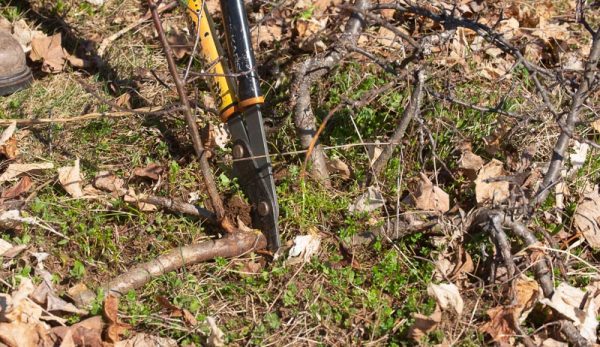
On and off over the past couple years, I have been working on clearing small, twisted apple trees from my farm’s older pastures. It might sound strange at first, but having wild apple trees take over old livestock pastures is a known phenomenon.
I’m not opposed to letting some of the nicest trees grow up and produce fruit (as some already have). But the numerous smaller trees must go in order to keep things tidy and restore the pastures to full productivity. The question is, what’s the best way to go about removing the trees?
Since I’m not looking to plow and plant the pastures, I don’t have to worry so much about removing the roots. I just need to cut the trees below ground level and mow the pastures for a few years. Then the roots should die off and eventually rot away.
This leaves me with two options. I can brush hog the trees, or cut them down by hand.
I’m always game to experiment in search of the best solution to any project. So of course, I’ve tried both approaches. Along the way, I’ve found pros and cons for each.
Let’s take a moment and explore them.
Read more: If apple trees invade, consider letting some grow to maturity.
Brush Hogging
Pros
If you want to quickly get a pasture looking nice (at least from a distance), brush hogging is a great solution. Using powerful thwacking blades, a brush hog can slice through small trees and cut down grass and weeds at the same time. That’s a big positive if you’re working in late summer when the trees disappear among the brush.
A single mowing can make a huge difference. And if you hit the area a second time later on, the results will look even better.
Cons
Brush hogging is a bit messy. The blades will shatter trees and spread them across the pasture. You’ll need to rake up the bits and pieces.
And since the blades can’t cut all the way to ground level, the trees will leave behind battered stumps that stick up out of the ground. These can be hazardous for humans and livestock alive, not to mention riding mowers with blades that cut closer to the ground than a brush hog.
You may have to go back and cut these stumps by hand. That takes time and effort. And since they’re no longer attached to visible trees, finding every stump can be challenging.
Read more: Reclaiming an overgrown field? Check out these tips.
Hand Clearing
Pros
If you want to do a tidy job, hand clearing is the way to go. Using pruning loppers, a hand saw and maybe a digging shovel, you can travel from one tree to the next. Simply cut it down just below ground level, leaving no visible stumps behind.
Since you’re cutting down entire trees, you won’t have to deal with the mess of shredded branches left behind by a brush hog. And if you have to cut down all the stumps left behind by a brush hog anyway, hand clearing isn’t necessarily more laborious.
Having the tree trunks to grab hold of can actually give you more leverage for reaching belowground to cut the trees.
Cons
It takes time to clear a large number of trees by hand. You won’t get the rapid visual improvement offered by brush hogging.
Hand clearing is also best done in the spring, before grass and weeds grow up. Once brush takes over, it’s harder to find small trees and readily reach their stumps. Speaking of which, small pasture-grown apple trees tend to grow in very twisted, gnarly ways. So you may have to cut some of the branches to reach the base of each tree.
After experimenting with both techniques, I’m personally drawn to hand clearing. It’s tidier and doesn’t really take more time. But if you need fast results—or if you’re looking to clear a field in late summer—brush hogging can be an equally good place to start.
Have fun clearing!




